Time Travel Research Center © 2005 Cetin BAL - GSM:+90 05366063183 - Turkey/Denizli
Ether-Energy-Generator
Alfred Evert
Preliminary Remark
One aim of earning Free Energy is to tap unlimited ´sea of energy of
universe´. There is talked about space-energy, zero-point-energy, vacuum-energy
etc. - however these terms are contradicting by themselves: space is
abstract term (which can not content energy), zero-heat implies zero-energy
(if thought by particles as common understanding), within vacuum no forces
can affect (because real vacuum excludes everything). It´s true: whole
universe is full of energy - however ´energy´ again is totally abstract term,
empty of real content.
Real however is, within universe exists only that One, that unique substance of ether - and this ether continuously is in motions most complex. If these - real-mechanical - movements of real-material ether should be used for drawing off energy, these movements are to manipulate in adequate manner. Naturally there is no energy to ´win´, only for short phases forces are to ´divert´ for some profit (while sum of all ´energies´ naturally keeps constant).
Many explorers made numberless experiments and many ´generators´ are known, which - at least sometimes - did produce clear surplus of energy (see e.g. Motor-Flywheel-Generator). Some use turning constructional elements for energy-production or as trigger. Final aim however is solution without moving parts, thus ´solid-state-generators´. In principle, these machines are build for accumulating frequencies of (previous space-, zeropoint-, vacuum-energy, or real) ether, building up swinging motions within oscillating circuits, lastly transformed into optimum usable shape of electric energy.
These constructions are build by normal electronic parts with known functions and characteristics. Explorers search for best circuits and optimum timing of elements. Obviously are coming up effects, nevertheless these machines got not ready for production and marketing. So it´s obvious too, real causes for effects are not known, thus no conscious design is possible.
I don´t understand much about electronics and at first, I don´t want to know much of known knowledge, in order to be able to think ´free´ (and naturally some ideas most ´naive´ will result). However I try to explain appearances of radiation, electrons, charges, electric flow etc. by my understanding of ether and based at these insights to design senseful conceptions.
Following sections of this workout are to read by these preliminaries. These considerations are my contribution for solution and might be, some specialist, explorer or experimenter gets valuable hints for integration of these aspects into his conceptions. Following sections at first are simple descriptions of some aspects for ´gathering´ ether movements, as basis for further considerations.
Energy-gathering Antenna
Numberless waves or radiation lashes down onto surface of earth, naturally
or man-made by diverse transmitters, a real mess of motions. We can detect
directly only appearances of light or also of gravity. Communication units
for example can filter certain frequencies out of jumbled reception by
complex techniques. If however most possible energy of incoming swinging
motions should be used, no filter is demanded but chaos must be structured.
Antenna serve for reception of electromagnetic waves. These are build by electric conductor, around which swinging motions lean on resp. run alongside. At each end of wire, wave turns on its head and runs back. If wave lengths and wire length correspond, swinging motions are build up. If most possible wave lengths are to gather that kind, many wires should be used.
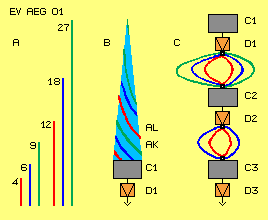 At picture EV AEG 01 at A schematic is shown a bundle of these antenna-conductors.
Lengths should show systematic order. Some will use golden-section, other
will take most important knots of global-scaling. I would prefer rule of 2/3
with 2- and 3- and even 4-fold, because by my understanding, universal
frequencies of ether are structured by this pattern (details see Ether-Physics
and -Philosophy) and also radiations have to swing most resonant to these
basic relations.
At picture EV AEG 01 at A schematic is shown a bundle of these antenna-conductors.
Lengths should show systematic order. Some will use golden-section, other
will take most important knots of global-scaling. I would prefer rule of 2/3
with 2- and 3- and even 4-fold, because by my understanding, universal
frequencies of ether are structured by this pattern (details see Ether-Physics
and -Philosophy) and also radiations have to swing most resonant to these
basic relations.
So antenna wires should show lengths in relation of 4-6-9 and 12-18-27 (or in addition of 36-54-81 and even of 108-162-243), as integer multiplication of essential constants of nature or known wave lengths.
Like schematic sketched at this picture at B, whole bundle of antenna-wires (AL, German Antennen-Leiter) should be used, e.g. spirally winded around an antenna-core (AK, grey) of dielectricum. Tesla for example had mounted rather long and rather thick antenna at his legendary car.
Ends of conductors are to combine by well shaped connection e.g. to short cupper pipe or even better to a sphere (C1). Via diode (D1) swinging motions are guided further down and back-swinging is eliminated.
Surface of previous sphere represents a capacity, practically a capacitor (C1), however with only one surface, e.g. without contrary pole. These constructional elements are to build e.g. by cupper and surface could be protected by dielectricum. This constructional element is called ´capacity-surface´ at the following (opposite to normal dipole-capacitor).
At this picture at C now schematic is shown further way of incoming swinging motions. A row of diodes (here e.g. D1, D2 and D3) should be installed. Probably capacity-surfaces (here e.g. C1, C2 and C3) should be installed between.
Between these elements, swinging motions should be allowed to move at diverse ways of differing lengths (here marked by different colours and different long curves), where lengths again should be arranged systematic. Between two diodes, swinging can run ahead and back, at all wires same time.
At entrance of each diode occur different situations, depending on actual overlays, resulting compensation or addition of two, some or even many frequencies that very moment. Diode should be controlled by threshold value (e.g. ´Zener´-Diodes), so only strong ´signals´ come to next circuit.
Now, swinging motions passing a diode, no longer show its original frequency. Energy of each swinging motion involved however is added into energy of signal. Within each further circuit thus come less, same time stronger swinging motions.
However these swinging motions come into next circuit not by certain tact, thus waves there run un-regular. In order to strengthen order, at each further circuit should be used less connecting wires, like here schematic marked between C2 and C3.
At the other hand, no complete steady swinging is demanded, if signals of constant frequency are not necessary input for consumers. At last level e.g. could be installed diode with rather high threshold value, allowing strong signal to enter last capacity-surface (here not drawn). At this surface, signal runs around resp. becomes even spread charge (e.g. for periodic supply of consumer).
Within air (and term of air-ether is avoided) swirl numberless swinging motions, i.e. huge amount of energy exists - however ´force-less´ because of absolute chaotic overlays of all actual motions and their vectors. By previous principle, some order is to install within chaos, so reasonable amount of energy becomes usable.
Energy-suction by Permanentmagnet
Generator for producing electric flow in principle is build by rotor and
stator. At most simple case are installed permanentmagnet within rotor and
coil within stator (or several of). Normally both elements move relative to
each other at surface of cylinder. At some of previous mentioned experiments
resp. generators these elements are arranged at circled surfaces. Here now
surface between elements is shaped like jacket of truncated cone (practical
compromise between cylinder and circle surfaces).
At picture EV AEG 02 at A schematic is shown cross section of that unit. Within housing (here not drawn) is beard turnably a shaft with its rotor (RO, light-red) in shape of truncated cone. Outside at rotor are installed permanentmagnets, their north poles (N) showing outward (thus all south poles S showing inward towards shaft).
Stator (ST) has corresponding shape of truncated cone, only with some larger diameter. At stator could be installed coils (SP, German Spule, at picture left side), however with windings radial showing outward (so axis of coil-core shows into tangential direction).
Only wires inside, opposite to north poles are effective. So it would be sufficient resp. better, if only a bundle of parallel wires (DL, German Diagonale Leiter, at picture right side) would be installed at stator. All upper ends of bundle are connected and all ends downside are connected. Each bundle of ´diagonal conductors´ (DL) upside is connected with source of charge (LQ, German Ladungsquelle, defined later) and bundle downside is connected with consumer (VB, German Verbraucher).
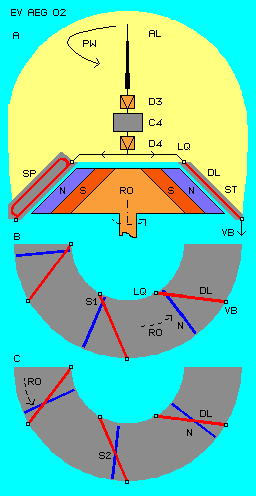 At
B schematic is shown jacket (at plane level) of truncated cone (grey),
alongside which elements move relative to each other. Permanentmagnets are
long-stretched, north pole (N, blue) is long rectangle, its longitudinal
axis showing into radial direction. Here as an example are drawn three
permanentmagnets.
At
B schematic is shown jacket (at plane level) of truncated cone (grey),
alongside which elements move relative to each other. Permanentmagnets are
long-stretched, north pole (N, blue) is long rectangle, its longitudinal
axis showing into radial direction. Here as an example are drawn three
permanentmagnets.
At this jacket-surface are also drawn three conductors (DL, red) of stator. These wires (resp. bundle of wires) are arranged some diagonal, outside-down showing ahead in turning sense (here some overdrawn). So between north pole (arranged in straight-radial direction) and conductors (arranged some diagonal) is angle of some degrees.
This angle naturally could also be achieved by north pole arranged little bit diagonal. North pole and conductor thus will never come into completely congruent position, there come up only points of intersection (e.g. at S1, German Schnittpunkt), which are more or less long depending on angle between elements.
While turning of rotor (RO) northpoles wander alongside jacket of truncated cone. At C situation is shown, where rotor did turn some ahead (in comparison with situation at B). Point of intersection (S2) now is positioned some outward.
Special property of this concept is, relative speed between north pole and conductor increases as point of intersection moves from inside towards outside. (This effect also occurs if magnets and coils are installed at circled surfaces, however not paid attention to at known generators).
Function of magnets at generator is, at first to generate charge onto conductors and second to impress motion-ahead onto charge. Both acts demand work and above this, induced flow produces ´opposite magnetic field´. Again work is necessary to overcome ´forces of attraction´. Now here, magnet comes not abruptly and into complete congruent position with conductors. Separation of both elements occurs smoothly, thus with less resistance. Above this, demanded workload essentially is to reduce, if at entrance of conductor already charge is existing.
This source of charges (LQ, German Ladungsquelle) schematic is marked at this picture upside at A. Upside of generator, here are sketched previous antenna conductors (AL). Via diode (D3) swinging motions comes onto capacity-surface (C4), swinging further on at this surface as motion pattern of charge.
Following diode (D4) now is to control that kind, charge can flow into conductors (DL) of generator, short time before that conductor is crossed by north pole. Magnets thus no longer has to attach charges onto wires, but only has to affect additional impulse-ahead onto charges already moving ahead. Point of intersection moving ahead by increasing speed, thus practically ´builds up bow-wave´ of increasing speed - by most few workload.
Antenna serves like a hollow, into which motion-energy of all incoming swinging ´disperses´. Analogue to tornado (´where air ´escapes´ upside out of funnel) or analogue to water-whirl (if water downside at centre steady ´gets lost´) one can imagine, whole ether of wide environment builds up a potential-vortex (PW, German Potentialwirbel, marked by yellow ´cloud´).
Real processes are these: each swinging occurs into all directions of space same time, at radiations with additional impressed motion-ahead. There is all times a component of motion, ´trembling´ into radial direction of antenna, to and fro. From all directions, motions are running towards antenna, which is protecting versus all motions of each contrary direction (from backside of antenna), i.e. back-trembling (outward from antenna) becomes weaker. That´s why swinging motions become attached at antenna and run alongside its surface.
If now previous generator takes off swinging motions from antenna on and on, motion-components towards outside of antenna again become weaker. Thus also at swinging motions further outside, motions into direction towards antenna become superior in strength. Thus this generator ´sucks in´ more swinging-energy than would be available without that (backward-affecting) change of motion´s structures.
Motion-components radial towards antenna, within ether can not run parallel (because there are no gaps within, thus no ´density´ can increase), but only at spiral tracks. Resulting of is previous mentioned potential-vortex, which now by itself overlays additional incoming swinging, thus this vortex affects with strong order-function. Onto conductor of antenna thus hit ether motions already better structured. By previous mentioned ways of diode-cascade well are to coordinate swinging motions of high energy, which lastly are available at capacity-surface as pattern of charge.
This generator delivers pulsating direct current. As a variation, previous diagonal conductors (DL) could also be winded by loops around truncated cone (like previous coils with outward showing windings (SP), however as steady twisted bundle, practically a ´spiral coil´). Also two conductor-circuits could be build, delivering phasewise shifted flow in contrary direction, thus usable like alternating current.
In general however, this solution is not real optimum, even this generator works much better than common generators. Here still electric flow is produced by mechanical work. Source of charges here is produced by ether-energy, impulse-ahead however not jet is produced automatic.
Energy-Funnel Flat-Coil
Previous rotor shows typical characteristic of motion of our commonly known
material world: material of shaft moves rather slow within space, material
outside at rotor move by much faster speed. This fast motion runs within
resting environment, where free movable parts (e.g. of air) mediate
differences of speeds easy.
Ether does not know parts, whole ether is gapless coherent. That´s why typical processes of motions within ether are characterised by relative resting ether outside and most activity of motion can only come up inside near centre (details see e.g. ´Potential-Vortex-Cloud´ of Ether-Physics and -Philosophy). By this point of view, previous rotor is not really ether-adequate constructional element.
At picture EV AEG 03 now is shown element rather ether-adequate, at A in shape of simple spiral. This spiral is made of electric conducting material, e.g. by cupper-wire. This spiral should be ´winded loosely´, wire should not be isolated, distances should be fixed with most few material. Looking downward at spiral, it should turn inward-left.
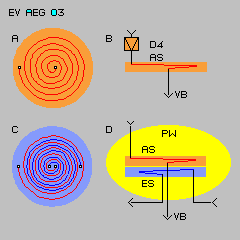 At
B this spiral is sketched by cross sectional view. At outer end, conductor
should be connected with antenna e.g. of previous design via diode (D4).
This constructional element thus is called ´antenna-spiral´ (AS) or antenna-coil.
Inner end of conductor guides to consumer (VB). Spiral should be build at
one level (only for better understanding of conductor´s way, spiral at
picture is drawn some diagonal). Similar ´flat coils´ were used in early
radio-receivers, Tesla did use similar coils by large dimensions.
At
B this spiral is sketched by cross sectional view. At outer end, conductor
should be connected with antenna e.g. of previous design via diode (D4).
This constructional element thus is called ´antenna-spiral´ (AS) or antenna-coil.
Inner end of conductor guides to consumer (VB). Spiral should be build at
one level (only for better understanding of conductor´s way, spiral at
picture is drawn some diagonal). Similar ´flat coils´ were used in early
radio-receivers, Tesla did use similar coils by large dimensions.
At C now within previous antenna coil (red) is drawn second conductor (blue) also as a spiral. This second coil could be at same level like first coil or e.g. direct below of antenna-coil. Design at two levels is shown at picture at D by cross sectional view. Blue spiral is called ´exciter-spiral´ (ES) or exciter coil, because through this coil phasewise is send direct current.
If one believes in common science, electric flow runs by light-speed through wires. A flow-impulse thus shows same absolute speed outside of coil like inside of. From outside of spiral however, angles speed of that flow gets faster and faster to the centre.
Quit sure however is, flow within exciter coil induces flow within parallel wires of antenna coil running into same direction. So also induced flow will show increasing angles-speed towards inside of spiral.
Flow is charge moving ahead alongside surface of conductor (details see following section). Charge is ether movement. Ether does not know parts. So never exists sharp border of any movement within ether (opposite e.g. to previous rotor at its border as material appearance). Thus ether is in motion also far outside of conductor, synchronous to motion of charge resp. flow, only some weaker depending on distance from conductor.
This will mean, also ether upside of antenna coil is influenced by motion´s component again of increasing intensity resp. angles speed towards centre. Thus exciter flow indirectly results potential-vortex (PW, schematic marked by yellow ´cloud´) within ether. Like any potential vortices, this pattern of motion produces self-dynamic with self-acceleration (e.g. well know at hurricanes etc.). Exciter coil must not drive this vortex steady, but short flow impulses will do, just because potential vortices run by itself on and on - and because this motion´s pattern is absolutely typical for movements of ether within ether.
This intensive motion of Free Ether naturally affects back towards surface of conductor. So motion´s pattern of charge are initiated resp. charge is accelerated into turning sense of spiral. Again, this moving charge running faster and faster inwards results suction effecting backward outside.
Analogue to previous ´suck-in´ also this antenna spiral will draw swinging motions off antenna attached at outer end of spiral. However now with this conception, mechanical work no longer is demanded, but short initiation momentum by pulsating direct current within exciter coil are sufficient input. Essential work of generating charges and influencing motion-ahead here is done automatic by mechanic of ether by itself - because these motion´s pattern are totally adequate to properties of ether.
By the way: electric flow is produced - however nowhere corresponding ´energy´ got consumed. At tornado or water whirl, potential vortices are driven by higher static pressure outside - and that air pressure or water pressure in total keeps constant, no matter air or water is standing or moving. Only within vortices, static and dynamic pressures are different than outside of.
Born of short and only temporary order of motion´s vectors (which by steady repeating can also be continuous), forces with usable effects can result of totally normal chaotic motions of air- or water-parts. Quite comparable are structuring processes of ether´s motions described upside.
If large antenna coils are used, also other effects might occur. For example, ether motions could become visualized by smoke. Within large circles outside of coil, abnormal magnetic appearances could occur. Even levitation effects could come up (which however are no anti-gravity). At later sections, constructional version with less ´side-effects´ is shown. At first however, general characteristics of charges and flows and general energy-sources are to discuss.
Energy-Source Ether-Pressure>
In 2003 and 2004 I described elementary motion´s pattern of ether at Ether-Physics
and -Philosophy. There in 2005 I will describe appearance of gravity and in
2006 of electromagnetism in details. In anticipation of, now are to mention
only some relevant facts of.
Electrons are sphere-shaped motion systems by potential vortices. Radiation like ´photons´ are analogue pattern and their vortices-structures are wandering through space. Atoms are accumulations of these ´Potential-Vortex-Clouds´. Material parts are accumulations of atoms. Outside of that ´Bounded Ether´ is ´Free Ether´ and that is relatively resting resp. only in motions of quant-small distances. Towards inside, motions of these vortices systems become more wide. All motions all times are running into all three dimensions, so move at spiral-bended tracks, within Free Ether like within occurrences of Bounded Ether.
All appearances of Bounded Ether have an ´aura´, i.e. ether´s movements don´t end at fix borders but spread far out into surrounding ether. Within these intermediate zones thus smooth transition of small-scale to coarse motion structures exist. Total ether around such vortices systems is superior, its fine swinging presses onto coarse vortices clouds from all sides. At the one hand, tendency to accumulation of likely appearances results, at the other hand e.g. electrons are pressed towards conductor surface.
Surface of material bodies is ´rough´, because aura of atoms or their Potential-Vortex-Clouds reach out different lengths into space. Within these aura-depressions of material surfaces electrons can ´hide´, for example as electrostatic charge. Only if surface is regular shaped these charges can come into motion by larger scale, i.e. electric flow can come up alongside conductor.
The more electrons sit at surface, the stronger is ´voltage´ (relative to conductor with less electrons attached). Lastly all vortices structures sitting at surface build one common layer of coordinated motions. If however layer got too thick (limit of capacity is exceeded), some motion´s parts escape (or are broken off by external motion impulses). If now charge resp. electric flow should be ´manipulated´, actions must fit to characteristics of their motion pattern.
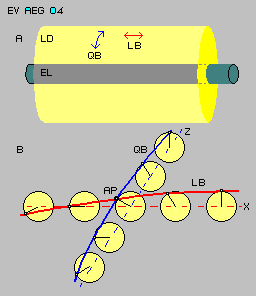 At
picture EV AEG 04 properties of charge are shown schematic. Around electric
conductor (EL, German elektrischer Leiter, grey) could sit separated
electrons, at normal case however around conductor is attached complete ´charge-layer´
(LD, German Ladungsdecke, yellow), like a blanket or coat. This ether in
principle is in motion all times into all directions. So all times exist
motion components into longitudinal direction (LB, German Längsrichtung) and
around conductor as cross-motion (QB, German Querbewegung). As long as no
flow is running, both motions are relatively steady ´trembling´ ahead and
back (if only these two motion´s directions are looked at).
At
picture EV AEG 04 properties of charge are shown schematic. Around electric
conductor (EL, German elektrischer Leiter, grey) could sit separated
electrons, at normal case however around conductor is attached complete ´charge-layer´
(LD, German Ladungsdecke, yellow), like a blanket or coat. This ether in
principle is in motion all times into all directions. So all times exist
motion components into longitudinal direction (LB, German Längsrichtung) and
around conductor as cross-motion (QB, German Querbewegung). As long as no
flow is running, both motions are relatively steady ´trembling´ ahead and
back (if only these two motion´s directions are looked at).
Longitudinal motion commonly is called ´electric field´, motion-around conductor, cross to longitudinal motion, commonly is called ´magnetic field´. Field is pure abstract term, appearances however totally concrete are based on totally real motions of real substance called ether. Pattern of motion of previous charge coat schematic is shown at this picture at B.
Observed is an ether-point (AP, German Ätherpunkt), i.e. one certain portion of ether is looked at while moving. This point is only fictive position within ether, in sense of geometric point. This point is no separated ´particle´, because all ether is gapless matter, is real continuum, not dividable into any parts with fix borders.
All ether points thus are connected most direct manner with all neighbours. There can´t exist any motion like by ´billiard-spheres´, where any motion runs into a gap between others. If one ether point is moving in space, all others has to move synchronous and each motion into one direction demands balancing motion cross to.
At this picture as an example schematic is shown longitudinal motion (LB) of five ether points (AP resp. small black marks). These ether points are connected ´fix resp. rigid´, here represented by red curve (of each neighbouring ether points). At X-axis (dotted line) are drawn five left-turning clocks, each watch-hand shifted by 30 degrees (showing into directions from 12- to 8-o´clock). At ends of each hand observed ether points are positioned.
If now all clocks turn synchronous, motion towards left comes up. However, clock quite left side already shows 8-o´clock, i.e. there motion already is running to right side. Distances between ether points thus would not be constant - resp. can keep constant only if same time motion cross to comes up - and it must be exactly right-angled - like ´phenomenal´ property of all electormagnetic appearances - by common understanding not to explain.
Here for example that ether point quite left side should have to turn around X-axis by balancing motion. Then however, all other ether points should have to move synchronous to, i.e. all ´clock-hands´ can not turn only at one plane.
Starting from central ether point (AP), this cross-motion (QB) of Z-axis is marked analogue (all clocks turning likely in this plane right angle to X-axis). So there is steady turning and winding and swinging into all three dimensions same time (changing values of Y-axis are represented by direction of each clock-hand). Naturally also layers upside and downside of these observed ether points swing analogue and synchronous (again with correspondingly shifted positions of each ´clock-hands´). Complete coat of charge around conductor is swinging by that motion´s pattern.
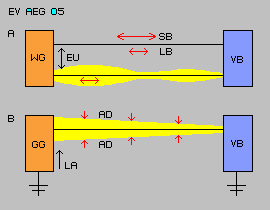 At
picture EV AEG 05 at A schematic is drawn an alternating current generator (WG,
German Wechselstromgenerator) and a consumer (VB) and two conducting wires
between. Generator at first has to bring charge onto conductors, thus must
build up previous charge layer. This layer, by previous considerations, is
swinging ahead and back into all directions, Thus also one component of
motion is trembling into longitudinal direction (LB). By common frequency of
50 swinging motions each second, generator is shifting charge to and fro, at
both conductor wires. This motion of flow (SB, German Strombewegung) is
overlaying normal longitudinal motion (LB).
At
picture EV AEG 05 at A schematic is drawn an alternating current generator (WG,
German Wechselstromgenerator) and a consumer (VB) and two conducting wires
between. Generator at first has to bring charge onto conductors, thus must
build up previous charge layer. This layer, by previous considerations, is
swinging ahead and back into all directions, Thus also one component of
motion is trembling into longitudinal direction (LB). By common frequency of
50 swinging motions each second, generator is shifting charge to and fro, at
both conductor wires. This motion of flow (SB, German Strombewegung) is
overlaying normal longitudinal motion (LB).
Common understanding is, electric flow should move by light speed through good conductor (through solid material, not alongside its surface, by common understanding). While one phase of 0.02 seconds light comes ahead 6.000 km far. AC-generator near source of Rhein thus has to push flow until mouth of Rhein and back again. Really however, at conductors of that lengths, all energy ´got lost in resistance´, at end of conductor no flow will exist at all.
Real cause of resistance is, AC-generator is steady impressing motion ahead onto normal swinging of charge layer, into one direction and 0.02 seconds later into opposite direction. At process of electric flow, no ether is really moving ahead. Its normal turning only is overlaid by second turning. Only seemingly results flowing-ahead (see further down resp. chapter ´Seas-Waves´ at Ether-Physics and -Philosophy: waves are running ahead for miles - apparently, really however waters are rotating only at relative small distances, only by differing speeds ahead and back, resulting of overlay of only two circle motions).
If this generator accelerated charge in longitudinal direction, same time and same amount motion right-angled to has to be accelerated (because ´electric and magnetic fields´ correlate inevitably). Next moment, motions are decelerated and again accelerated into opposite direction, thus previous overlay is completely to change. All layers of all charges must change directions and speeds of all movements synchronously. Charge layer has no fixed border, thus also all surrounding ether is involved correspondingly.
Essential property of ether is its inertia: as all ether points correlate to each other in absolutely direct manner (with no smallest gap between nor any possibility of differing density), all motions structures unavoidable has tendency to resist versus any changes. So AC absolutely is enemy of ether. Charge layer once send onto conductor naturally is deformed by steady to and fro and naturally some parts of charges got ´radiated´ into environment. Naturally AC-generators can only transform energy (EU, German Energie-Umsetzung) from one shape into other - by enormous losses.
At this picture at B is drawn analogue configuration, now however with direct current generator (GG, German Gleichstromgenerator) and only one conductor wire to consumer (VB). Backward wire is not necessary, both units can be connected with ground. Generator has to work only for accumulating charge (LA), i.e. must guide most possible thick charge layer onto conductor. Rest is done automatic by ether´s work.
Each normal DC-generator builds up charge. By previous proposals was shown how swinging motions of natural source are to use by proper construction of antenna, how mechanical work can be improved by rotating magnets or how charges are to suck-in via flat coils by pure electronic measures of exciter coil. Already at these applications, ether-pressure has essential affect. Now for flow of DC alongside surface of conductor, ether pressure (AD at previous picture) is unique driving force.
Generator only generates charge at conductor, at its best only pulsating, most effective in shape of previous piling-up ´bow-wave´. Charge layer thus is essentially higher at the beginning of conductor than at its end. Within area of bow-wave movements are relative intensive, i.e. aura reaches far out into Free Ether. Within this intermediate zone, thus wide scale motion´s differences are to balance.
All ether motions probably are of same speed everywhere (light speed or multiple of). At Free Ether motion run within small area, comparable with small swinging at end of a rope. At opposite end of that ´rope´, at charge layer, swinging motions are of larger scale. Short swinging will be congruent to long swinging some times, afterwards however contrary. Long swinging can escape that contrary motion only by wandering to opposite end (towards conductor). Lange swinging is not really decelerated by that act, because short moment later is driven by motion of Free Ether now actually into same direction.
This example points out function of ´Free Ether Pressure´. This force naturally affects much stronger onto thick layer of charge with corresponding wide aura than onto parts of conductor with less charge. Free Ether presses flat any charge-accumulations - by ravenous speed alongside whole conductor, by minimum resistance, also at long distances.
That pressing-flatten same time impresses motion-ahead onto previous general pattern of motions of charge layers. As any acceleration of that ´electric field´ same time affects acceleration of inevitable cross-motion, intensity of that Bounded Ether gets stronger as a whole. That´s why DC shows dramatic less resistance than AC.
Each new bow-wave of pulsating DC enters into that motion´s pattern ´heated-up´ resp. is really pulled in. At DC all motions all time run into same direction. Ether shows property of inertia - of motion. Indeed, ether nowhere ever can be stopped. Any motion once initiated, e.g. overlay into direction-ahead (all times inclusive correspondingly accelerated cross-motion), thus goes on affecting ahead - however same time ether some behind is forced to corresponding acceleration (only of smaller scale depending on distance). So also this ´suction-effect´ is elementary property of ether - if assumed gapless and without possibility of changing density (without these necessities of motions of flowing charges, no induction would be possible). So for transport of charge at a conductor, pulsating DC is most effective procedure.
This ether-pressure permanently affects onto all ´coarse´ ether-vortices. We don´t feel it (like fish doesn´t feel water-pressure or we don´t feel air-pressure), because our atoms are swinging sufficiently resonant to Free Ether motions. Well known experiment demonstrates enormous power of: strong impulse of electric flow is send through bundle of thin wires (flex). ´Normally´ likely electrons should have to blow up that net of wires. Really however these wires got crumpled-up - visual result of ether-pressure onto thick charge layers around wires (where wires of that bundle mutually ´protect´ each other, thus got pressed together).
Ether pressure also gets obvious if charge got ´too thick´ resp. charge is pressed outward at spikes of surface in shape of sparks (where ´free´ electrons are pressed to sphere-shaped potential-vortex-clouds, just by that pressure all around, so from continuous layer of charge got born separated units). If ´barrage´ of ether-pressure results heavy motion of atoms of conductor, parts of charge are spilled out also in shape of ´photons´ (no ´particles´, but only wandering vortices pattern of ether motions).
This enormous energy of ether pressure is ´for free´ and should be usable. Most effective would be, not to ´consume´ this primary charge. That charge should only run around within system by pulsating acts. Only secondary appearances should serve consumers.
Pulsating Circuit
At first again, solution with mechanical control by rotating parts is shown,
using example of Electric-Dynamo.
Animation and picture EV AEG 06 are discussed at this chapter. There and in
an other chapter system is described in details. So here once more is
mentioned only essential principle of process.
 Three capacity-surfaces are used. Their capacity varies as intermediately
parts of surfaces are protected versus ether pressure by dielectricum.
Depending on material of dielectricum, capacity of likely surfaces can vary
by multiple.
Three capacity-surfaces are used. Their capacity varies as intermediately
parts of surfaces are protected versus ether pressure by dielectricum.
Depending on material of dielectricum, capacity of likely surfaces can vary
by multiple.
Dielectrikum (DI, white) here is shaped as rotating beam, capacity-surfaces (CU, blue) are build by sheet cupper in shape of circled sectors. If dielectricum is turning, one surface becomes less covered while following surface becomes more covered correspondingly. Different blue colours at this animation show each varying capacity of charges.
All three capacity-surfaces are connected by three wires (blue) in turn. If dielectricum turns left, charge moves from one surface to next each right side (so charges remain within system all times). These three wires are guided via transformer (TR) as primary coil, thus phase-shifted induced secondary flow (red) is available for consumers (VB).
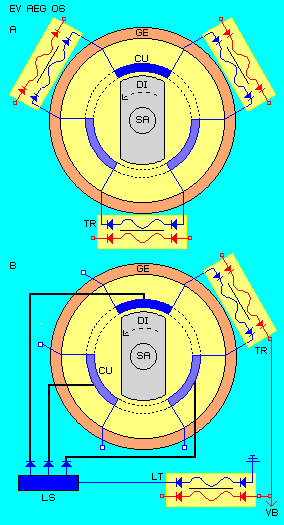 Similar machines were build and did work (e.g. by Hyde), however these
systems did work with common capacitors (with each two dipole-surfaces) and
charges had to act via air (like at most electrostatic units). However, one
does not need dipoles and no ´protons´ - if these particles would really
exist. Principle shown here does work only with negative charges of more or
less ´volume´ at surfaces of varying capacity. Charges keep all times at
good conductive surfaces, only by differing strengths of charge-layer.
Similar machines were build and did work (e.g. by Hyde), however these
systems did work with common capacitors (with each two dipole-surfaces) and
charges had to act via air (like at most electrostatic units). However, one
does not need dipoles and no ´protons´ - if these particles would really
exist. Principle shown here does work only with negative charges of more or
less ´volume´ at surfaces of varying capacity. Charges keep all times at
good conductive surfaces, only by differing strengths of charge-layer.
If charge actually is open for Free Ether pressure, charge layer there is pressed flat and thick charge layer is pressed into gap between next capacity-surface and dielectrium actually covering that surface. Free Ether pressure can affect only via narrow surfaces aside, just like demonstrated by Casimir-effect. No ´rejection of likely electrons´ exists in reality, however motion´s patter of charges build capacity-layers decisive stronger within ´protected areas´ than outside of.
Rotor naturally is to drive by motor. However, no magnetic contrary forces are to overcome like at common generators, but maximum forces likely to Coulomb-force will come up. Thus energy input will be some tenth of induced current (what some explorers achieved by similar units, however only for some times because machines were not build consequently ether-adequate).
Naturally all capacity-surfaces are to charge by maximum when starting machine (by external source resp. battery). Naturally also in running mode, some amount of charge gets lost by radiation into Free Ether (and e.g. Tilley called isolation of his generator most important problem), thus permanent recharging is necessary, however only by small amount.
Here at picture at B schematic is shown concept of autonomous running system. Some components at A here are not drawn, some others added.
From current available to consumer (VB), one part is guided into charge-transformer (LT, German Ladungstrafo) as primary coil (red) and induced secondary current (blue) is guided into storage for recharging (LS, German Speicher für Ladung). From this capacity, charge flows to previous three capacity-surfaces (CU) via conductive wires here marked by thick black lines. Naturally these connections are to install as ´one-ways´ by diodes. Charge really will flow only occasionally for refreshing of surfaces (only if these surfaces actually show less capacity resp. corresponding few ´voltage´).
At this constructional principle thus enormous power of ether pressure affects pulsating direct current running around, while rotating dielectricum all times produces new ´gradients´, each from surface of decreasing capacity to following surface of increasing capacity. This process is controlled mechanical (thus no pure solid-state solution), nevertheless this control is simple like safe operating.
Even similar (however not consequent constructed) electrostatic units did work successful (however not stabile but e.g. ´weather-dependant´), I can not understand why since one year nobody did realize this proposal of electrostatic-dynamo. Probably name of this concept is misleading: not electro-static here is affecting but pure electro-dynamic, this machine is really an ´electro-dynamo´. Perhaps previous detailed description of function of ether pressure now will help understanding this clear solution.
Magnet-Pump
Electric current is overlay of ´static charge´, thus overlay of ether motion
by ether motion. Basic principle of processes already are described by Ether-Physics
and -Philosophy, for example at chapter 03.03 ´Overlays´. Here at picture EV
AEG 07 that process schematic is shown once more.
Ether is in complex motion at tracks, resulting of addition of different circle motions. Over simplistic one could imagine, an ether point (AP) at its process in time is turning around fulcrum (D1, German Drehpunkt) by radius (R1), like marked at A by diverse positions, turning left assumed.
Overlay comes up as at the end of this radius (R1) new fulcrum (D2) exists, around which additional turning by radius (R2) occurs (like marked at B by two positions). So two ´clocks´ are turning within space, where outer end of outer clock-hand marks track of ether point.
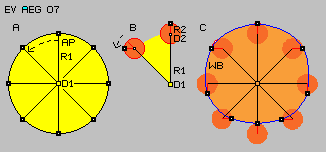 If both turnings run synchronous, ´wave-track´ (WB, German Wellenbahn, blue
curve at C) results, i.e. like sea waves really are running. One ´water-point´
moves fast ahead upside (here towards left) and moves back slowly downside (to
see by distances of different lengths of ways within likely time units).
Separated water parts rest within relative small area, while wave appears
far running ahead.
If both turnings run synchronous, ´wave-track´ (WB, German Wellenbahn, blue
curve at C) results, i.e. like sea waves really are running. One ´water-point´
moves fast ahead upside (here towards left) and moves back slowly downside (to
see by distances of different lengths of ways within likely time units).
Separated water parts rest within relative small area, while wave appears
far running ahead.
Analogue to this process, ether all times is positioned within relativ small area, turning at only narrow circled tracks, which however are enlarged by overlays (depending on relation of radius of overlaid turning motion) and thus shows different speeds within different phases.
Analogue to discussed motions of previous picture EV AEG 04 neighbouring ether points move at likely tracks, where however each ´clock-hand´ is at some correspondingly shifted position. At wave´s top, both clock-hands show upward, i.e. water stands high and motions towards left side add to high speed. Further back at place of actual wave´s valley, water surface is some deeper and motions of both clock-hands subtract to slower motion backward right side.
Opposite to water, ether is homogeneous gapless substance. There is no place to pile up ´masses´, i.e. there is no place for motions running ahead - unless ether previous positioned there would escape aside (and all neighbours behave correspondingly, by wide detour back to observed wave´s hill).
Also this fact was discussed already at previous picture EV AEG 04: each swinging into longitudinal direction inevitably is bound to synchronous swinging right angles to. Within ether, there is no ´water surface´, i.e. all ether upside like downside of observed position must swing synchronous. Only at very long distances (really by astronomic relations, e.g. like within galaxies or atoms), radius of overlays can decrease, i.e. motion can come back to circled track (resp. to swinging pattern of Free Ether).
Essential insight is: at electric current no ether is really moving ahead (and no electrons are crawling ahead within conductors and really no ´particles´ are moving at all). Impression of flow only appears based on varying turning speeds of relative stationary ether. ´Rule-of-right-hand´ (by conventional understanding of current´s direction) exists concerning electric flow, thus analogue to right-turning thread (while here all times real direction of current is assumed). So in reality, current ´flows´ all times at spiral tracks, showing left (by view into flow´s direction). Current ´flows´ not like at common thread with constant gradient, but faster ahead (and correspondingly faster cross to) and some slower, depending on phases of overlaying turning motions.
Ether by itself never moves ahead far out. What really does wander far ahead however is structure of motion´s pattern: overlay by itself is build up within generator and only that additional turning motion is running alongside conductor (so only motion´s pattern is wandering from one portion of ether to next, not ether by itself is wandering in space). Ether positioned in front takes motion of overlay and ether positioned behind comes back to its original motion pattern.
This process is comparable to short gust of wind, which builds up one (or some few) sea waves. Waves run ahead and ´get lost´ by friction of water parts. Gapless ether is much more viscous than water. Building up an overlay costs relative strong power, because same time must be build up far reaching corresponding balancing motions. At the other hand, within homogenous ether are no losses by friction, so overlaid motion´s pattern can spread unrestrained.
Analogue to ´flow of electric current´ behave ´field-lines´ of permanent magnets, like schematic shown at picture EV AEG 08 at A by example of rod magnet. Material of magnet is arranged that kind, ether between material parts (resp. between special motion´s pattern of that Bounded Ether) is overlaid by corresponding pattern.
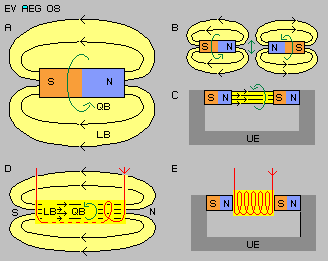 That motion´s pattern exits and transmits into space ahead of north pole.
However, there are no separated ´field-lines´, but that pattern again is
coherent ´layer´ of synchronous, however some phase-shifted swinging of all
neighbouring ether points. So there exists also component of longitudinal
motion (LB) plus cross motion (QB) inevitably (analogue to previous
mentioned pattern of EV AEG 04).
That motion´s pattern exits and transmits into space ahead of north pole.
However, there are no separated ´field-lines´, but that pattern again is
coherent ´layer´ of synchronous, however some phase-shifted swinging of all
neighbouring ether points. So there exists also component of longitudinal
motion (LB) plus cross motion (QB) inevitably (analogue to previous
mentioned pattern of EV AEG 04).
Field lines exit at north pole and ´flee´ back to south pole. This area here is rough sketched by yellow region (different strength of field etc. is well known). Permanent magnets can ´work´ astonishing long times, however their areas of affect are rather limited. This appearance clearly marks effect of ether pressure.
Free Ether presses versus all coarse motion´s structures resp. eliminates all appearances which are not sufficient resonant to universal basic ether motion. Obviously these magnetic field lines are not sufficient adequate, so are dispersed by Free Ether already at short distances.
That ´magnetic motion´ has chance to ´survive´ some longer e.g. when ´fleeing´ into narrow positioned piece of iron, which inside can take corresponding overlaying motions. This motion´s pattern exits this protection area at other end of iron, so there again is exposed to Free Ether. Pressure onto that new ´north pole´ now pushes iron towards north pole of magnet. So there exist no ´attracting forces´ but pressure of Free Ether versus coarse motion´s pattern affects this appearance.
Permanent magnet is also good example of previous mentioned ´suction-effect´ of ether. Magnetic motion pattern is build up inside of magnet. This overlay can not come up and end abruptly, on contrary, ether already in front of south pole must show corresponding pattern, thus ´balancing area´ must exist. Magnetic strength clearly shows, how intensity of overlay-impression comes up into axial direction towards south pole.
Coming from north pole, ether is moving by likely pattern. That´s why field lines from north to south pole tie together resp. why magnetic field lines are closed loops in general. Magnetic field alongside rod of magnet is rather inhomogeneous because Free Ether at this area can eliminate different strength of overlaying motions.
Rather homogeneous however is magnetic field direct in front of north pole. If however two north poles (like shown at B) are positioned opposite, motion´s directions (longitudinal like cross to) are contrary. Ether can not take contrary motions within short distances - that´s why likely poles reject. Again: there are no separated field lines struggling but two coherent layers of mirrored pattern need distance to balance differences.
Relative homogenous magnet field exists between poles of horseshoe magnets (like schematic shown at C). Motion pattern exists from north pole, runs via air gap to south pole, and there is exposed to pressure of Free Ether only at outer sides. Within U-shaped iron (UE, German U-förmiges Eisen) motion pattern flows back to north pole, protected by iron material´s structure (while electric flow sufficiently is protected already at outer surface of conductors).
Magnet field analogue to rod magnet exists within coil when electric flow runs through (like schematic sketched at D). Outside of coil, magnet field again is rather inhomogenous, while inside of coil longitudinal like cross motions (LB and QB) are homogenous. Motion pattern of electric flow around conductive wires build up common ´motions-layer´ alongside total inner surface of cylinder.
Now it´s good idea to combine both congruent appearances (like schematic shown at E). Coil is winded (without iron core) around air gap between poles of horseshoe magnet. So magnetic flow supports motion of electric flow and vice versa. Both magnetic fields (yellow) add their affects. Field keeps homogenous even distance between poles is much larger than at normal arrangements.
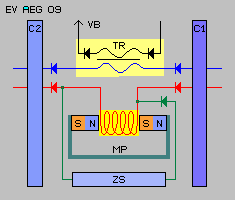 An application of that magnet-pump (MP) is shown at picture EV AEG 09. At
example of previous Electro-Dynamo was mentioned, charges of capacity-surfaces
(C1 and C2) should be used and charges should remain within system all times.
If one capacity-surface actually has more charge (here C1, dark blue) than
an other capacity-surface (here C2, light blue) electric current runs via
conductive wire (blue) until both ´capacitors´ take likely charges. If this
wire is arranged as primary coil of transformer (TR), secondary coil (black)
induces current usable for consumers (VB).
An application of that magnet-pump (MP) is shown at picture EV AEG 09. At
example of previous Electro-Dynamo was mentioned, charges of capacity-surfaces
(C1 and C2) should be used and charges should remain within system all times.
If one capacity-surface actually has more charge (here C1, dark blue) than
an other capacity-surface (here C2, light blue) electric current runs via
conductive wire (blue) until both ´capacitors´ take likely charges. If this
wire is arranged as primary coil of transformer (TR), secondary coil (black)
induces current usable for consumers (VB).
Now here is installed additional connection between both capacity-surfaces (form C1 to C2). This second conductive wire (red) is guided via previous magnet-pump (MP).
It´s know, balancing of charges lastly affects likely amount of charges at both capacitors. It´s also known, first current will ´over-spill´, thus more than half of charge-difference is flowing to the other side (and easy to explain by previous description of inertia of ether and its once started motions).
´Spilling-back´ is to avoid by diodes. In order to achieve continuous process, each delivering surface must be ´pumped out´ at its best for next phase. Above this upside was mentioned, overlaying motion-ahead by itself could run on and on. At the other hand, forces are demanded if motions got stopped and must be restarted. These problems could be solved by following circuit.
If capacity-surface left side can take no more charge, flow existing at red wire still can go on running via green conductive wire into intermediate storage (ZS, German Zwischenspeicher). From there, green wire leads back to coil of magnet-pump, while direction of flow again is controlled by diodes. Current now can go on within that loop, at this phase driven resp. at least supported by magnetic field of horseshoe magnet. However, there is no current generated nor magnet and conductive wire are moving relative to each other.
Opposite this will mean, still existing flow affects previous mentioned suction-effect back onto capacity-surface C1. From there thus still charges are drawn off and guided into intermediate storage ZS.
If sufficient gradient between both capacity-surfaces thus is achieved, within next phase charges could spill-back (from C2 to C1). However it´s much better to use three capacity-surfaces and current is running all time into same direction. Each one surface delivers charge to second receiving capacity-surface, while third surface is ´pumped-off´.
Charge within intermediate storage or running around within intermediate circuit (green), at least by parts will wander into receiving surface at next phase. Within area of red circuit overlaying motion-ahead keeps constant to a great extent, i.e. at start of next phase abruptly will run strong flow into receiving surface.
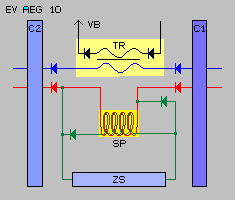 These
phases are to control electronic via voltages between capacity-surfaces (probably
much harder to construct than simple mechanic controlling of previous
Electro-Dynamo). It´s also question whether voltage-differences can be build
up in larger scale (e.g. for supplying ´normal´ consumers). This application
however is good example for handling charges and currents most ether-adequate.
And this conception is important hint for following solution of real solid-state
machine with performances you like it.
These
phases are to control electronic via voltages between capacity-surfaces (probably
much harder to construct than simple mechanic controlling of previous
Electro-Dynamo). It´s also question whether voltage-differences can be build
up in larger scale (e.g. for supplying ´normal´ consumers). This application
however is good example for handling charges and currents most ether-adequate.
And this conception is important hint for following solution of real solid-state
machine with performances you like it.
Variation of this conception is sketched at picture EV AEG 10. Instead of permanent magnet here magnetic field is produced by coil. This coil-pump (SP, German Spulen-Pumpe) at the one hand exists of coil (red) of current between capacity-surfaces (from C1 to C2). At the other hand exists coil of secondary circuit (green), which is running via previous intermediate storage (ZS).
If current flows between capacity-surfaces, current within side-circuit is induced and thus intermediate storage is loaded. If primary current ends, motion´s pattern still keeps constant as current is going on within side-circuit. Again each direction of currents is to control via diodes.
Spiral-Cascade
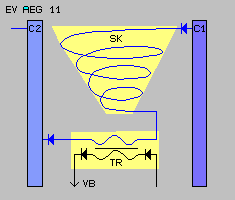 Objectives
of all previous circuits was to use current between capacity-surfaces for
induction of secondary current available for consumers. This currents
however demand, not only balancing of charges between both surfaces, but to
´pump-off´ delivering surface at its best (so gradient of voltages is
produced for next phase).
Objectives
of all previous circuits was to use current between capacity-surfaces for
induction of secondary current available for consumers. This currents
however demand, not only balancing of charges between both surfaces, but to
´pump-off´ delivering surface at its best (so gradient of voltages is
produced for next phase).
At previous concepts thus additional current-circuits were installed with embedded permanent magnets or coils. Now best solution would be, ether by itself would do that job direct manner.
At picture EV AEG 11 only one conductive wire (blue) is drawn between capacity-surfaces (C1 and C2). Via transformer (TR) usable current for consumers (VB) is induced like at previous solutions. Most effective shift of charges now however is to achieve, if current is guided via spiral-cone-shaped conductor (SK, German Spiral-Kegel). This concept is similar to flat-coil of upside picture EV AEG 03, here however windings are not arranged at one level but alongside surface of truncated cone.
Effect of ´electron- or ion-cascade´ is known by special arrangement of conductors, like used e.g. at Testatika. Picture EV AEG 12 shows construction in principle.
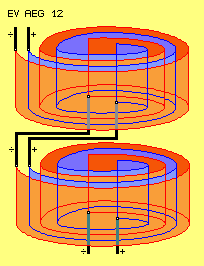 Sheets of capacitor are winded spiral. One sheet takes negative charge (red),
on surface takes positive charge (blue), between both sheets isolating
material is installed (here not drawn). Several of such units are arranged
one by one, where each inner end of sheet is connected with outer beginning
of next corresponding sheet (here marked by thick black lines).
Sheets of capacitor are winded spiral. One sheet takes negative charge (red),
on surface takes positive charge (blue), between both sheets isolating
material is installed (here not drawn). Several of such units are arranged
one by one, where each inner end of sheet is connected with outer beginning
of next corresponding sheet (here marked by thick black lines).
When discharging that capacitor-cascade, more ´electrons´ exit than originally put into system and ´ionisation´ is detected. Both effects however are only side-appearances, process by itself exclusively is based on pressure of Free Ether onto charges resp. overlaying motion ahead of current. Above this, no normal capacitor (-dipoles) nor isolation are necessary. Much more effect will show naked surfaces or wires (here thus only minus-sheets) which are exposed to Free Ether directly.
Ether is moving by light speed (at its local limited areas) and electric current can also move (approximately) by light speed (apparently ahead). Nevertheless, differences of lengths alongside spiral bended surfaces are important. Layer of charge show basic pattern of motions onto which is impressed overlaying motion-ahead (and synchronously also cross to), both by certain speeds.
At inner side of spiral, distances become shorter and space becomes more narrow, i.e. ether there comes into ´stress-situations´. Resulting of is thicker layer of charges at inner parts of surfaces. Free Ether affects stronger pressure into these thicker balancing areas, i.e. also with accelerating effect. Relative to length of conductor thus current will flow (apparently ahead) faster and faster towards inside of spiral. Alongside bended sheet-surfaces, charge layer will ´slip´ ahead increasingly faster. At round wire-surfaces, motions wind around-ahead correspondingly faster.
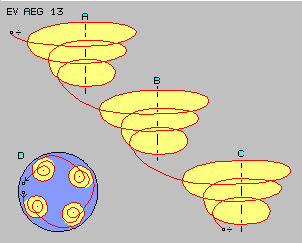 At
picture EV AEG 13 schematic is drawn such an ´acceleration-cascade´, where
conductive wire (red) is winded spiral and its negative charge resp. current
runs through three of these truncated cones one by one (A, B and C). At the
end of that unit, not ´more electrons´ appear, but charge there is impressed
by overlaying motion much stronger and faster into direction ahead.
At
picture EV AEG 13 schematic is drawn such an ´acceleration-cascade´, where
conductive wire (red) is winded spiral and its negative charge resp. current
runs through three of these truncated cones one by one (A, B and C). At the
end of that unit, not ´more electrons´ appear, but charge there is impressed
by overlaying motion much stronger and faster into direction ahead.
Within such coil-cones for example is piling up accelerated ´bow-wave´ with corresponding inertia into direction-ahead, however also with corresponding ´suction-effect´ into backward direction. Previous mentioned ´pump-effect´ thus is generated by this conception, now however only by direct affecting pressure of Free Ether onto charge-layer.
So it´s important, Free Ether can affect most free onto charge layers, i.e. these coils should be winded loose. Such units could be build by large scale or several of these coil-cones could be installed within small box, like e.g. sketched at this picture at D by view top-down (four coil-cones at different levels are arranged within box of not-conductive material). This current now should be allowed to ´fall into depression´.
Charge-Depression
It´s common understanding, current is caused by voltage-difference between
negative and positive. Commonly observed are number of electrons and protons
and their movements caused by ´rejection´ of likely and ´attraction´ of
unlike poles. These are secondary appearances, if real existent at all.
Free electrons can attach at conductors and are integrated into common layer of charge. Only when pushed or hit out of that layer, this package of motion again will become sphere-shaped ball of certain motion pattern and volume (pressed in shape by surrounding ether of all sides, like universal ether also moving towards left in general).
Naturally some times might be broken out off common layer also ´false turning´ pattern, however these ´protons´ won´t survive long time. If colliding with electrons, both contrary overlays are eliminated (and motions disperse into Free Ether).
There remains a ´gap´ without specific motions, into which naturally other electrons or protons can fall. This violent and disturbing reaction however is not identical with wanted continuous flow of charges alongside of conductors. So at the follow, again only more or less charge (layer of ´negative electrons´) at conductors is assumed and discussed.
Charge layer can be impressed motion-ahead into one or contrary direction of conductor. Impressing overlaying motion can be done by workload (like at all common techniques) or effects of ether motion by itself can be used (like discussed here). Especially impressive example of pressure of Free Ether onto charges is well known Faraday-cup, like schematic shown at picture EV AEG 14 at A.
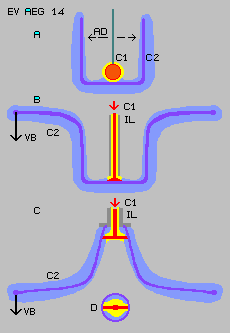 Metalic ball (red) with isolating rod (grey) is charged by any source (here
not drawn) and put to inner side of metal-cup (C2, dark blue), which itself
stands at isolating support (here not drawn). Charge layer (yellow) of ball
moves to surface of cup. Inside of cup, pressure of Free Ether (AD, German
Äther-Druck) is mirrored, pressing flat charge layer (light blue). Charge
flows at outer surfaces of cup (where only normal ether pressure exists).
Metalic ball (red) with isolating rod (grey) is charged by any source (here
not drawn) and put to inner side of metal-cup (C2, dark blue), which itself
stands at isolating support (here not drawn). Charge layer (yellow) of ball
moves to surface of cup. Inside of cup, pressure of Free Ether (AD, German
Äther-Druck) is mirrored, pressing flat charge layer (light blue). Charge
flows at outer surfaces of cup (where only normal ether pressure exists).
Pressure inside of cup is strong enough to press charges at most high points completely off, i.e. ball is to take off cup discharged in total. If this process is repeated, cup outside shows higher voltage than originally existing at source.
This experiment of electro-static is well known. Instead of process step by step, effect also will work continuously, like schematic shown at B. From source of charge resp. current (C1) is installed a connection to inner bottom of cup by isolating conductor (IL, red plus grey, German Isolierter Leiter). Original charge layer (marked yellow) is pressed alongside inner surface of cup and build up much larger and stronger charge layer (light blue) at outer side of cup. Naturally this pressure also affects back alongside conductive wire. Flowing ahead however will be continuous, if charge of outer surface steady (or phasewise) is guided to consumers (VB).
At this picture at C alternative design of that ´depression for charge resp. current´ is shown. Conductive wire here is not guided through inner side of cup to its bottom. Isolated conductor (IL) from source of charge (C1) now is guided direct through bottom (well isolated) and outer surface of wire is in contact with inner surface of this ´bell´. Conductive wire thus practically is transformed to an hollow conductor (well known is, inside of exist no fields at all). Here however this ´pipe´ (C2) opens like a funnel, so charges are pressed outside (and further on guided to consumers). This constructional element at the following is called ´capacity-bell´.
Downside at the middle at D, contact between conductor and bell is sketched by cross sectional view. Conductive wire for example is split into two contacting surfaces, so there is room for charge layer to flow off bottom of bell.
By previous spiral-truncated-cone was demonstrated how charge becomes overlaid by accelerated motion ahead by ether-conform building up of a potential vortex, inclusive self-acceleration and suction-effect. By this example of Faraday-cup (in adequate shape) was demonstrated how ether pressure accelerates charge layer towards outer surfaces and thus charge-depression is organized. From source to that depression, further charges can follow (so current is achieved), where charges won´t ´got lost´, but are still available for further usage.
Ether-Current-Generator
It´s correct to assume, ether in total is full of ´energy´ in shape of
various motions. With its small-scale universal movement´s pattern, Free
Ether affects pressure onto all motion-pattern of more coarse scale. Some of
these appearances of Bounded Ether well can exist long term, if sufficient
resonant to basic pattern. Some motion´s pattern can wander through space
and e.g. hit onto earth in shape of radiation various kind. These swinging
motions should be usable in shape of electric current if handling and
constructional elements are organized ether-conform.
At picture EV AEG 15 at B schematic is shown design of ether-current-generator, where previous constructional elements are combined as an example. As source for swinging motions resp. charges is used an antenna-unit (AT). Via spiral-truncated-cone (SK) charge gets overlaid by accelerating motion inside-ahead. Via capacity-bells (C1, C2 and C3) charge is guided to bell´s outside surfaces. From there, current is guided direct into ground (at C1) or to consumers (VB) (at C2 and C3).
Antenna (AT) could be rod-antenna (like discussed upside or like Tesla did use at his famous car). For stationary mode, antenna naturally could also be sphere-shaped (at its surface any frequencies are running around and easy to ´catch´, even by chance). Diodes should be installed at the end of antenna unit (or some diodes with intermediate capacity-surfaces could be used, like e.g. discussed upside at picture EV AEG 01), so swinging motions further on are directed ahead.
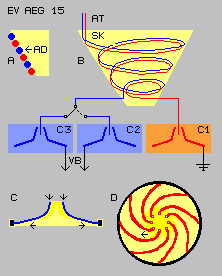 Here is drawn only one spiral-truncated-cone (SK). Naturally could be used
also real cascade of these units (corresponding to upside picture EV AEG
13). These conductor-spirals result acceleration-effect as mentioned upside.
In addition, these units affect structuring function onto various overlaying
swinging motions. At each inner side of cone, previous mentioned ´stress´
within ether comes up. Space for balancing motion´s areas becomes narrow,
i.e. no longer can take place any actually incoming contrary or phase-shifted
swinging motions. These various frequencies are forced to bundles of more
uniform motion´s pattern. Structuring force is most strong, because gapless
ether can not move abruptly into contrary direction without corresponding
wide balancing areas (in really astronomic relations).
Here is drawn only one spiral-truncated-cone (SK). Naturally could be used
also real cascade of these units (corresponding to upside picture EV AEG
13). These conductor-spirals result acceleration-effect as mentioned upside.
In addition, these units affect structuring function onto various overlaying
swinging motions. At each inner side of cone, previous mentioned ´stress´
within ether comes up. Space for balancing motion´s areas becomes narrow,
i.e. no longer can take place any actually incoming contrary or phase-shifted
swinging motions. These various frequencies are forced to bundles of more
uniform motion´s pattern. Structuring force is most strong, because gapless
ether can not move abruptly into contrary direction without corresponding
wide balancing areas (in really astronomic relations).
Nevertheless: ether motion can not only be pushed into that funnel. There must exist additional suction (while suction within ether is even more essential than at normal fluid processes). That ´suction´ is produced by previous capacity-bell, which here simply is sketched e.g. as C1. Continuously that unit sucks in charges, if charge accumulated at bell´s outer surface can flow off free.
This ´primary-circuit´ here is represented by red conductive wires. This part of construction ´destroys´ energy of ether-swinging motions. This part of energy can not be used direct kind, only side-effect of this process serves as ´motor´ for usage of other part of motion´s energies - here called electric current.
At previous spiral-truncated-cone (SK), parallel to red coil is drawn blue winding of conductive wire. Both wires are positioned narrow together, like sketched by sectional view at A. Especially at inner surfaces strong ether pressure (AD) affects. Current within primary conductor (red) naturally initiates corresponding current within parallel running secondary conductor (blue), like well known by any induction.
Primary charge layer now is moving not only around red wire, but at inner surface of that cone common layer of charge comes up. Overlay of motion-ahead of one conductor (red) thus is transferred also onto second conductor (blue). This process works most best at most even common surfaces, thus by most thin wires. At the other hand well could be used square conductors (with rounded edges), where each inner side of wires together build common plane (but spiral-cone-shaped) surface.
Only at the end of truncated cone (it must not be complete cone!) red and blue conductor wires are guided at separated directions. Red circuit ends within earth resp. is grounded, like discussed upside.
Blue conductor is also guided into capacity-bells (C2 and C3) and further on to consumers. Consumers have to do any workload, thus resistance comes up. In order to keep ether-motion (resp. current induced within spiral-truncated-cone) continuous, that current is guided phasewise into one (C2) and second (C3) capacity-bell.
Opposite to all previous concepts, here charge is guided alternating into two constructional elements, thus available for consumers by corresponding phases, e.g. for charging batteries etc. (here not discussed in details).
Special design of these ´Faraday-cups´ allows to introduce charge inside of bells, even at their outer surfaces exist actual higher ´voltages´ (thus constructional element of most important function). These bells not at all must be build by plane surfaces, also constructions analogue to ´Faraday-cage´ are useful (however cage open at one side), like schematic sketched at C by longitudinal view and at D by cross-sectional view.
It will make sense not to use only two conductors but bundle of wires (of red and blue functions). Within spiral-truncated-cone, these wires build relative homogenous surface, where charge layer at inner surface is especially important. Nevertheless, current runs alongside wire´s outer surfaces. At following constructional element, charge has to be pressed alongside inner surfaces of bell to its border.
This effect is also achieved, if shape of bell is build only by separated wires showing outwards. Common surface of wire-bundle (inside of previous truncated cone) thus gets broken up and charges now build layers around each separated wire. All charges are likely, all current motions are likely, i.e. with contrary movements towards each neighbouring wire. It´s clear thus ´rejection´ occurs, i.e. charges escape to border of that ´wire-spider´.
At outer border, all wires are connected to a ring (bell´s common border) as relative large capacity surface. Wires must not show accurate radial towards outside. If conductors are arranged spiral, distance between neighbouring wires increases slower, i.e. ether pressure between wires affects stronger and longer. This bell build be separated wires probably will work better than bell with continuous surfaces.
I´ll end this section with an provocative assumption: Tesla did use this solution at his famous car. Sure knowledge only is, rather large and thick antenna was installed and for starting usable energy, two rods were pushed into any ´black-box´. If previous conductive circuits between spiral-truncated-cone (SK) and capacity bells (C1 resp. C2 and C3) is open, nothing will happen. If however capacity-bell C1 comes into contact with red wires (first rod pushed into black-box), primary current gets started and gets running into ground (without direct usage, but only as motor for induction). If capacity-bells (C2 and C3) are connected with blue circuit (second rod pushed into black-box), usable current runs into batteries (and both clocks well could be mounted at one axis).
Summary
There are lots of (more or less) working units for usage of ´space-energy´.
These machines are based on known functions of electric and electronic
constructional elements. Common considerations are based at common
understanding of electrons, protons and electric current. However, only if
real essence of electricity gets known, machines are to design consequently
and will work steady.
All appearances are expression of ether and its movements. Only if ether is assumed to be gapless unique matter, inevitably must exist right-angled synchronous movements. Only by that understanding of ether, besides others, affects of ´magnetic and electric fields´ are to explain (and no other theory explains this elementary phenomenon).
Charge is not identical to single electrons, but is complete layer of motion pattern at surface of conductors. This relative coarse motion is pressed towards surfaces by much finer motion pattern of Free Ether (superior part of all ether). Current comes up by overlaying of motion-ahead. By common techniques this process is done by workload (thus only transforming one shape of energy into other shape, including losses). Free Ether affects current automatic, as thick layers of charges are pressed flat until equal spreading.
Motion´s layer also comes up at surfaces of antenna by input of radiations. These ether layers swing by different rhythm of incoming frequencies, thus multiply overlaid. Better order resp. simpler structure are to achieve by different ways between capacity-surfaces.
These swinging motions become flowing motion only if ´depression´ exists. That´s to achieve e.g. by flat-coil, where charge is steady accelerated towards inside-ahead by second coil (as triggering motor). This acceleration is also to achieve by usage of magnets, which increasingly faster move cross to conductor. This process builds up ahead-running bow-wave, which however affects also backward practically as suction, based at relative strong (motions-) inertia of all ether movements.
Depression area is to achieve very effective, if actual capacity of capacitors varies (and capacitors are constructed as ´capacity-surfaces´ without dipole-function). At Electro-Dynamo for example this is achieved by dielectricum passing by capacity-surfaces. Charges stay within system all times, however current between capacity-surfaces induces secondary current available for consumers.
Charge can be pumped between capacity-surfaces (above normal balancing of charges) when using permanent magnets and additional circuits with coils and intermediate storages.
If however one wants to use ´pure ether energy´, one has to ´catch´ charge by antenna systems (where sphere-shaped antenna are advantageous for stationary mode). Within spiral-cone-like winded coils, inner surfaces are exposed to pressure of Free Ether. At narrow inner sides affects higher ether pressure, by which acceleration of motion component ahead is achieved, so towards centre ether ´flows´ increasingly faster in relation to conductor (while ether really does not move ahead, but only actual movement´s pattern wanders ahead-inside faster and faster). Potential vortices like these are essential movement´s patter of ether, inclusive its self-acceleration and suction-effect.
Real cascade of these spiral-cones are usable, so at the very end more current exists than originally available. At the following, common charge-layer of narrow parallel arranged wires are to split, so around each single wire charge layer comes up. Analogue to well known effect of Faraday-cup or -cage resp. simply based on known ´rejection´, charge is pressed outward within such ´capacity-bells´.
All charges at a whole are gathered at outer ring, again building closed layer of charge. Also this constructional element represents depression, because inside charge is to introduce at wires, even outside at ring much higher ´voltages´ exists. These capacity-bells by itself represent variable capacities, increasing from inside towards outside, so are very important constructional elements.
Part of earnd and accelerated charge is to ´spend´ by running direct into earth or grounded mass. Only as side-effect, induction within parallel coil of previous spiral-truncated-cone produces usable current. As an example, current alternating is available for consumers via two capacity-bells.
By these principles of manipulating forces of given ether movements usable electricity is to achieve. Like this for example Tesla´s car did work. Naturally many variations of previous discussed constructional elements and circuits are possible. Presenting these considerations I do hope, physicists like experimenters got interesting stimulations and I am looking forward for resonance. For example I am interesting to learn, if functions of many known units of diverse explorers could be explained by these considerations or rebuilds improved by these proposals do better job. Naturally I am very interested to learn about experiments with previous constructional elements (because I do no experiments by my own). Thanks in advance.
Evert / 30.03.2005
UFO Propulsion Research... UFO Sevk Teknolojileri...
Hiçbir yazý/ resim izinsiz olarak kullanýlamaz!! Telif haklarý uyarýnca bu bir suçtur..! Tüm haklarý Çetin BAL' a aittir. Kaynak gösterilmek þartýyla siteden alýntý yapýlabilir.
The Time Machine Project © 2005 Cetin BAL - GSM:+90 05366063183 -Turkiye/Denizli
Ana Sayfa /
index /Roket bilimi /![]() E-Mail /CetinBAL/Quantum Teleportation-2
E-Mail /CetinBAL/Quantum Teleportation-2
Time Travel Technology /Ziyaretçi Defteri /UFO Technology/Duyuru